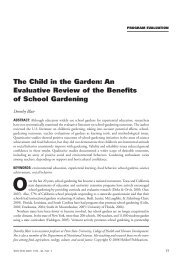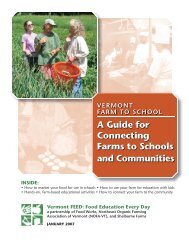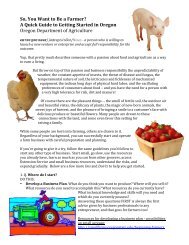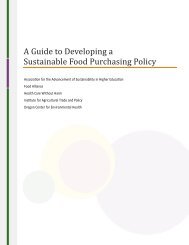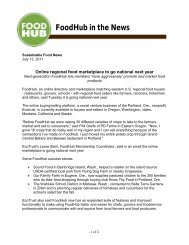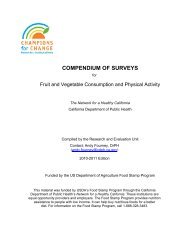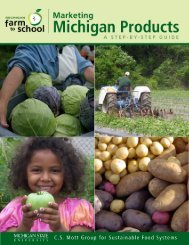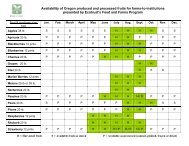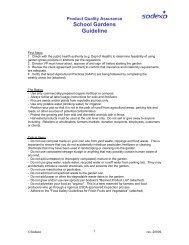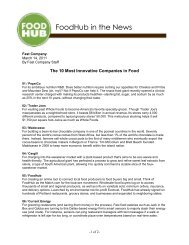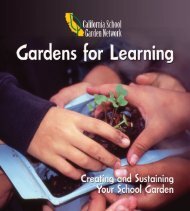eval report cover.indd - New Jersey Farm to School Network Wiki
eval report cover.indd - New Jersey Farm to School Network Wiki
eval report cover.indd - New Jersey Farm to School Network Wiki
Create successful ePaper yourself
Turn your PDF publications into a flip-book with our unique Google optimized e-Paper software.
IV. Conclusion and Recommendations<strong>Farm</strong> <strong>to</strong> school programs are based on the premise that students will choose <strong>to</strong>eat more healthy foods, such as fruits and vegetables, if the foods are fresh, locallygrown, picked at the peak of their flavor, and supplemented by educationalactivities that link them with the food cycle from seed <strong>to</strong> table. Since its launch a decadeago, the farm <strong>to</strong> school model has emerged as a strategy for schools <strong>to</strong> improve theircafeteria meals and incorporate educational opportunities for students. <strong>Farm</strong>ers havealso seen farm <strong>to</strong> school as an opportunity <strong>to</strong> explore new markets for their products.Th e term “farm <strong>to</strong> school” is better unders<strong>to</strong>od now than it was a decade ago, and thereis a growing body of <strong>eval</strong>uation results that document the process and outcomes offarm <strong>to</strong> school programs. However, well-constructed <strong>eval</strong>uation studies are still needed<strong>to</strong> <strong>cover</strong> information gaps and answer remaining key questions about farm <strong>to</strong> schoolimpacts.Due <strong>to</strong> the localized flavor of the program, the farm <strong>to</strong> school model is uniquely interpretedin every single program in the country. Th ere is a deepening understanding ofhow the model translates in different community conditions and in different growingregions. Th e program <strong>report</strong>s and <strong>eval</strong>uation studies referenced in this publication areevidence of the efforts underway <strong>to</strong> comprehend the multi-faceted implementationprocesses and effects of the farm <strong>to</strong> school approach.Th ere is a growing community of farm <strong>to</strong> school practitioners and <strong>eval</strong>ua<strong>to</strong>rs who arediligently working <strong>to</strong>wards validating the impacts of the farm <strong>to</strong> school model throughconcrete data and research. A <strong>to</strong>tal of 38 resources, program <strong>report</strong>s, <strong>eval</strong>uations andarticles were studied for this <strong>report</strong>. In presenting this review of <strong>eval</strong>uation findings and<strong>to</strong>ols from existing farm <strong>to</strong> school programs, we have tried <strong>to</strong> showcase the strength ofcurrent farm <strong>to</strong> school <strong>eval</strong>uation practice, as well as highlight the limitations and needfor future efforts. Furthermore, presenting findings from farm <strong>to</strong> school studies next <strong>to</strong>select findings from similar (but non-farm <strong>to</strong> school) school-based nutrition, health,and education interventions helps <strong>to</strong> place these farm <strong>to</strong> school findings in the largercontext of efforts <strong>to</strong> improve student health and education.In this concluding section, for each of the indica<strong>to</strong>rs highlighted in this <strong>report</strong>, wediscuss the gains made in understanding impacts of the farm <strong>to</strong> school model andfocus on future research needs.►►With regards <strong>to</strong> assessing interest in the farm <strong>to</strong> school approach, adequatebaseline data and feasibility analyses are available from across the country indicatingthat there is interest from school food service and farmers <strong>to</strong> participatein a farm <strong>to</strong> school program, as well as an understanding of strategies needed <strong>to</strong>make farm <strong>to</strong> school work under different conditions.Impacts on students represent one side of the farm <strong>to</strong> school equation. A majorityof farm <strong>to</strong> school <strong>eval</strong>uations are focused on changes at the student level,including outcomes related <strong>to</strong> knowledge and attitudes regarding local foodsand healthy eating and dietary behaviors. More comprehensive longitudinalstudies are needed <strong>to</strong> understand whether knowledge and awareness translates<strong>to</strong> specific changes in dietary behaviors and any subsequent health benefits asConclusions and Recommendationswww.farm<strong>to</strong>school.org 53



